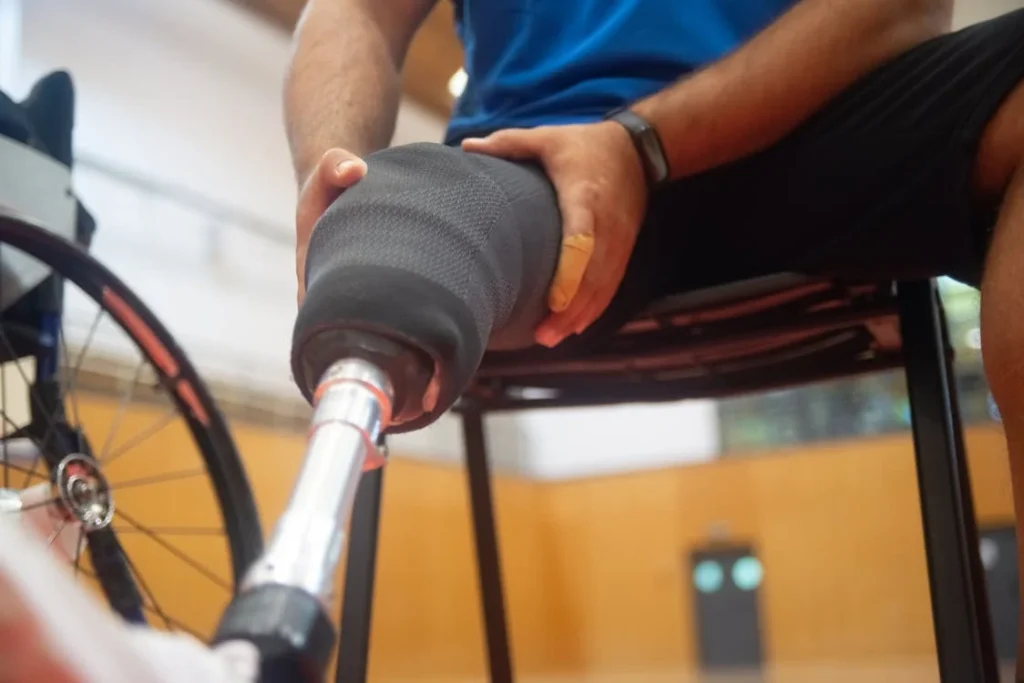The way a prosthetic limb holds weight is changing fast. For decades, prosthetics were designed with one main goal—to help people walk again. But now, we’re going much further. We’re not just helping people move. We’re learning how to help their bodies move better, longer, and with more ease. That means thinking differently about how prosthetic limbs handle weight.
Today’s researchers and designers are using powerful new tools. Artificial intelligence is helping us understand how people walk, move, and even stumble. At the same time, new materials are coming into play—materials that bend when they need to and stay firm when they don’t. These changes are helping us rethink how weight is shared between the limb and the ground. They’re also making prosthetics smarter, lighter, and more responsive than ever before.

A New Way to Think About Weight-Bearing in Prosthetics
Moving Beyond Basic Support
In the past, prosthetic limbs were mainly built to hold up weight. That meant building parts that were strong and stable, but not necessarily smart or responsive.
The focus was on function—getting someone walking again, or helping them stand without falling. It was a basic goal, and in many ways, it worked. But this kind of design often meant that users had to work hard to adapt to the device. The limb didn’t adapt to them.
Now, things are shifting. Designers are beginning to ask different questions. Instead of “how can this limb carry weight?” they’re asking “how should this limb carry weight for this user?”
This small change opens a world of possibilities. It means the limb is no longer just a tool—it becomes a part of the body’s system. It learns how to move with the person, not just under them.
Weight-bearing is no longer just about standing up. It’s about how pressure moves through the limb, how balance is maintained, and how the user feels after hours of use.
Does the prosthetic reduce strain on the rest of the body? Does it help prevent pain or fatigue? These are the new goals. And to meet them, we need smarter tools.
How AI Is Changing Prosthetic Design
Artificial Intelligence is playing a huge role in how we understand and build modern prosthetics. In simple terms, AI can take in huge amounts of data—more than any human could look at—and find patterns.
It looks at how people walk, how their bodies shift weight, and where problems show up over time. This kind of insight used to take months or years to figure out. Now, it can be done in days.
One of the key ways AI is helping is through gait analysis. When a person walks with a prosthetic, small sensors can track how their body moves. These sensors record things like step length, joint angle, and how the weight shifts from foot to foot.
AI then takes all this data and shows where the user may be struggling. Maybe their knee bends too much, or maybe the socket isn’t holding weight evenly. Once that’s known, the design can be adjusted to fix the problem—sometimes even in real time.
But AI doesn’t just stop at analysis. It also helps with design. Using machine learning models, engineers can predict how a new material or part will behave even before it’s built.
They can simulate years of walking in just a few minutes, testing different shapes, thicknesses, or material layers. This speeds up development and makes the final product more reliable.
In some advanced systems, AI is also being used to control prosthetic joints. These smart systems look at movement patterns and adjust how the limb responds—making a knee bend softer when going downstairs, or making a foot stiffer when walking uphill.
These micro-adjustments make the user feel more secure and reduce the mental effort it takes to walk smoothly.
The Rise of Adaptive Materials
Alongside AI, another breakthrough is happening in materials. Traditional prosthetics were made from hard plastics, metal, and foam. These materials were strong, but they didn’t move much. They didn’t change shape, and they didn’t respond to pressure the way a real limb does.
Now, we’re seeing the rise of adaptive materials. These are materials that can change their stiffness, shape, or structure based on how they’re used. Some get softer when they warm up from body heat.
Others tighten when pressure is applied, offering extra support only when it’s needed. Some even have tiny internal structures that shift and reshape themselves depending on how the limb is moving.
One powerful example is shape-memory polymers. These are plastics that can be set to a specific shape and then return to that shape when heated.
In a prosthetic socket, this could mean a material that adapts to the limb during the day, adjusting as the limb swells or shifts. This reduces pressure points and makes the fit feel more natural.
Another game-changing material is carbon fiber composites. These have been around for a while, but new versions are lighter, more flexible, and more durable than ever.
They’re being used in foot blades, knees, and pylons to create prosthetics that bend and rebound like natural joints. This not only helps with energy return—it improves how weight is transferred during each step.
There are also gel-based liners and smart cushioning foams being developed. These respond to pressure by softening in high-load areas and firming up in others. This kind of dynamic support helps protect the limb and reduce the shock that travels into the body.
A Better Future for Users
All of these advances—AI, adaptive materials, smarter design—point to a future where prosthetics are no longer just support systems. They’re intelligent, responsive, and personalized.
They learn how the user moves and help the body move better. This future isn’t about making one perfect product for everyone. It’s about making the right product for each person.
And the benefits are real. Users report less fatigue, fewer injuries, and more natural movement. They walk longer, stand taller, and feel more confident doing things they love. They also feel more connected to their prosthetic, because it works with them—not against them.
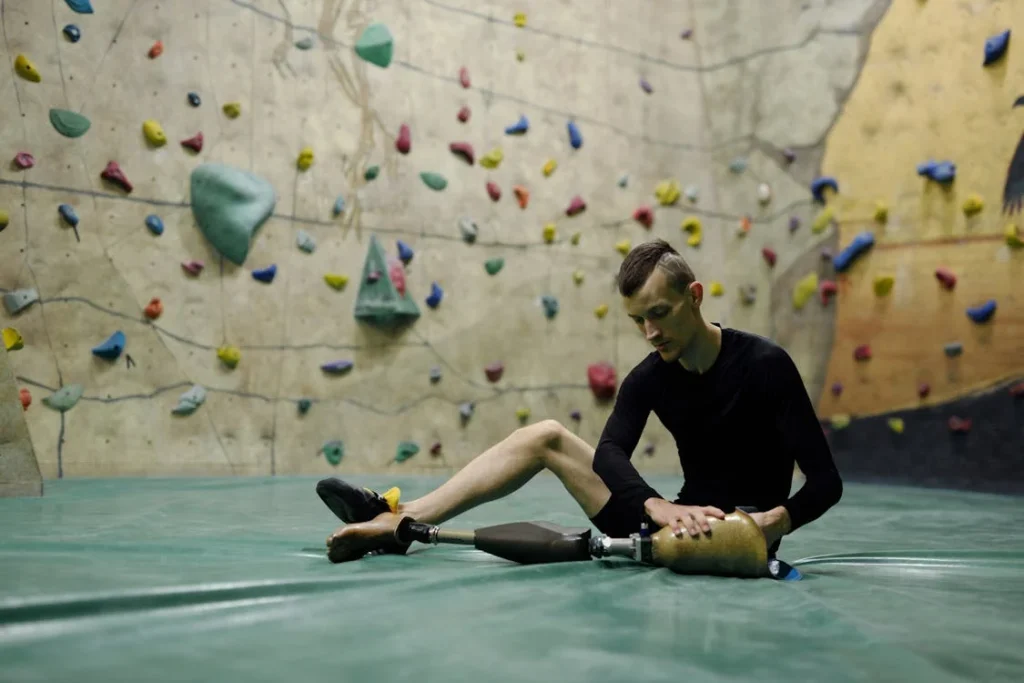
Designing for Real Life, Not Just the Lab
From Data to Daily Use
One of the most exciting changes in prosthetic design is that we’re now building devices based on how people actually live—not just how they perform in a clinic.
AI makes this possible by collecting movement data in real-world settings. Instead of only analyzing a person’s gait during short sessions on a treadmill, sensors can now track movement while the user walks at home, shops, climbs stairs, or plays with their children.
This data tells a much fuller story. It shows how a socket might loosen slightly after long wear or how a user’s gait changes when walking uphill.
By understanding these shifts, engineers can fine-tune the socket shape, material flexibility, and even how pressure is distributed across the limb.
Designing for real life also means listening to users in a new way. AI tools are starting to combine movement tracking with user feedback.
If a person says their leg feels sore in the afternoon, the system can look at what changed between morning and evening—step count, speed, incline, or temperature. These insights help prosthetists make better decisions about adjustments, without relying on trial and error.
This approach makes prosthetics not just smarter—but more human. Each design reflects not only science but also the stories and needs of the people who wear them.
Building Prosthetics That Learn
Imagine a prosthetic that doesn’t stay the same—it learns and evolves. That’s what’s starting to happen with machine-learning-based systems.
These are prosthetics with built-in AI that monitors the user’s walking patterns and gets better over time. Instead of needing a technician to adjust settings manually, the system makes those decisions on its own.
For example, if a person is walking faster than usual—perhaps catching a bus or running errands—the prosthetic knee can adapt and give more bounce or stiffness.
If the user slows down later, it can ease off. This level of real-time response means the limb doesn’t just carry weight—it carries it smartly, adjusting for what the body is doing in the moment.
Some systems are now being developed with “self-tuning” features. These features gather data from pressure sensors, angle sensors, and muscle signals (in myoelectric limbs). Then they adjust motor speed, joint resistance, or even socket pressure, all without outside input.
These intelligent systems are especially helpful for users who do a wide range of activities in a single day—walking, sitting, standing, climbing, and more.
This kind of adaptation means the prosthetic becomes more like a biological limb. It responds to change. It learns patterns. It even prepares for what’s coming next based on past behavior. It’s no longer just reacting—it’s predicting.
Making Adaptability Accessible
With all this technology, there’s an important question: can these advanced features be made available to everyone? High-end prosthetics in wealthier countries already include some of these smart tools, but the challenge is bringing them to wider markets, especially in countries like India.
That’s where local innovation comes in. By focusing on essential features that matter most—like adjustable fit, better shock absorption, and day-long comfort—teams like ours at Robobionics are making smarter prosthetics more affordable. We’re using local materials, mobile scanning tools, and modular components to reduce cost without cutting quality.
AI doesn’t always mean expensive. Sometimes it means efficient. With the right approach, even low-cost prosthetics can benefit from data-driven design and responsive materials. This opens the door for more users to experience high-level comfort, stability, and safety.
In many cases, we see people come in thinking they just need “something basic to get around.” But once they try a limb that responds to their weight, that fits without shifting, and that doesn’t wear them down—they realize what’s possible. That moment of discovery is where real change begins.
Shaping the Future Through Collaboration
One of the reasons this field is growing so fast is that designers, clinicians, engineers, and users are working together more than ever. Gone are the days when a prosthetic was designed in isolation, handed off to a clinic, and left unchanged for years. Now, it’s an ongoing process.
Clinics provide real-time feedback based on how users respond to different materials and settings. Engineers run virtual tests and adapt quickly.
Users give insights on comfort, lifestyle needs, and what’s missing. And AI ties it all together, translating that feedback into numbers, models, and improvements.
This open loop of feedback and innovation is driving progress at a rapid pace. And it’s happening everywhere—from small rural workshops to top-tier labs.
The message is clear: the future of prosthetics is not just high-tech. It’s high-touch. It’s built around real needs, real voices, and real lives.
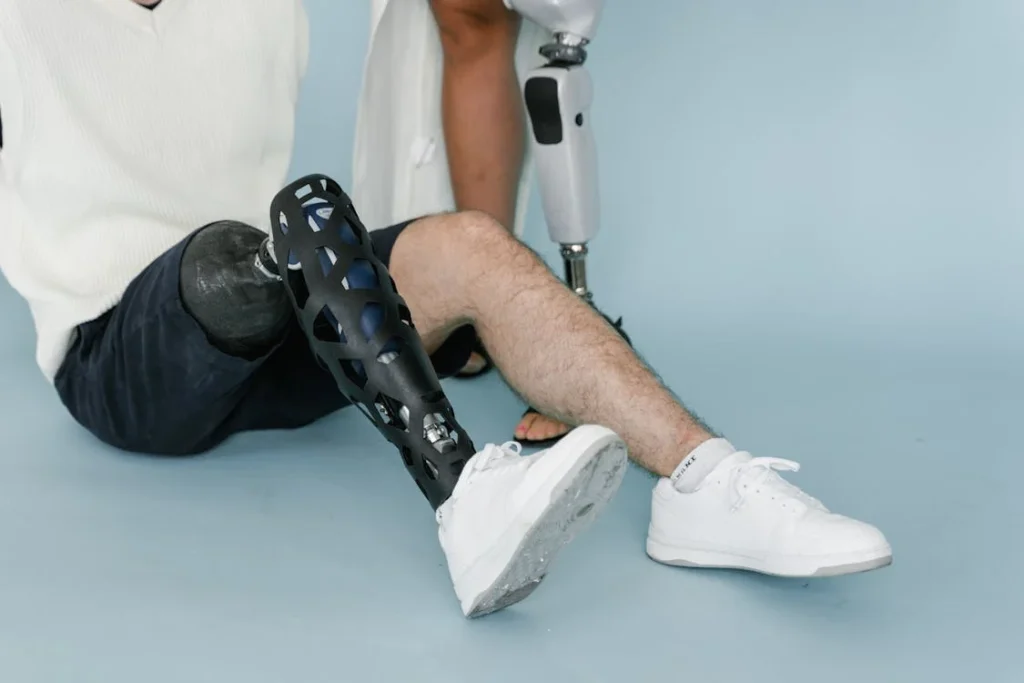
The New Era of Dynamic Weight-Bearing
Why Static Designs Fall Short
Traditional prosthetic designs are mostly static. Once built, they don’t change. They provide the same level of support, the same stiffness, and the same response no matter what the user is doing. While that might sound like stability, it often leads to discomfort, especially over time.
Our bodies are not static. They move, shift, and respond to the environment every second. Walking on pavement feels different from walking on grass. Standing still for ten minutes is very different from walking up stairs or running for a bus.
If the prosthetic limb doesn’t adjust to these changes, then the user has to. That usually means more energy spent, more strain on the natural limb, and more discomfort overall.
A dynamic design recognizes this truth. It aims to change the way weight is handled based on movement, speed, and even terrain. This is the future of weight-bearing prosthetics—ones that listen, react, and respond like the muscles and joints they aim to replace.
How Smart Materials Enable Dynamic Movement
The key to dynamic weight-bearing lies in the materials that can change on the go. These aren’t just flexible—they’re responsive. They act differently depending on how much force is applied, how quickly the user moves, or how the angle of impact changes.
One type of smart material gaining attention is viscoelastic foam. This material softens under slow, steady pressure but stiffens when hit quickly. That means it can feel cushioned when someone is standing still but give firm support during sudden movement or impact. It adapts without electronics—just based on how pressure is applied.
Another innovation is magnetorheological fluid, used in some advanced prosthetic knees. This fluid thickens or thins based on magnetic fields. When the user needs more support, a signal changes the magnetic field and the fluid stiffens instantly.
When support isn’t needed, the fluid softens, allowing smoother, more natural motion. This kind of fine control helps make the limb feel like a natural extension of the body.
We’re also seeing promising developments in programmable textiles—fabrics that adjust their tension and shape when exposed to body heat or moisture.
In the future, a socket might be able to self-tighten during activity and relax during rest, reducing pressure points and improving comfort without needing straps or buckles.
These technologies are still evolving, but they point toward a world where prosthetic limbs adjust the way living tissue does. They stretch, rebound, and offer stability only when and where it’s needed. For users, this means more freedom and less fatigue.
Enhancing Balance and Posture with Real-Time Feedback
Balance is deeply connected to how weight moves through the body. In people using prosthetic limbs, balance often becomes a conscious act.
They must think about every shift of weight, every step, and every angle. That mental effort can be draining—and it takes away from the experience of simply moving.
New prosthetics are beginning to close this gap using real-time feedback systems. These systems combine sensors and adaptive control to help users stay upright, aligned, and stable—without having to think about every move.
Some devices use tiny accelerometers and gyroscopes to detect shifts in motion. These signals are fed into a control system that adjusts the limb’s resistance or angle on the fly.
If the user starts to tilt, the system helps correct posture automatically. The user doesn’t have to stop and reset—they just keep going.
This kind of smart support does more than just prevent falls. It builds confidence. When users know their prosthesis has their back—literally—they take more steps, try new activities, and move with less fear.
Over time, this leads to better fitness, stronger muscles, and improved coordination. It’s not just the limb that adapts—the whole person does.
Integrating Sensory Feedback for Better Load Awareness
Another area of growth is sensory feedback—giving users a way to feel how their prosthetic limb is handling weight. This doesn’t mean recreating full sensation like natural skin, but even basic feedback can make a huge difference.
Some systems use gentle vibrations to signal pressure levels. If the heel of the prosthetic foot hits the ground too hard, a small vibration might let the user know.
Over time, users learn to shift their movements to reduce that impact. This kind of learning improves gait and balance naturally, without the need for conscious correction.
Other systems use pressure sensors in the foot or socket and convert those signals into electrical pulses sent to the skin. These patterns tell the user where the load is—heel, toe, inner edge, outer edge. It’s like a new sense of “proprioception”—the awareness of body position—even without real nerves in the limb.
This feedback helps users walk more symmetrically and confidently. It also helps detect issues early. If the user begins to put more weight on one side, the system can alert them, or even notify the clinician to check for alignment issues. That’s preventative care built right into the device.
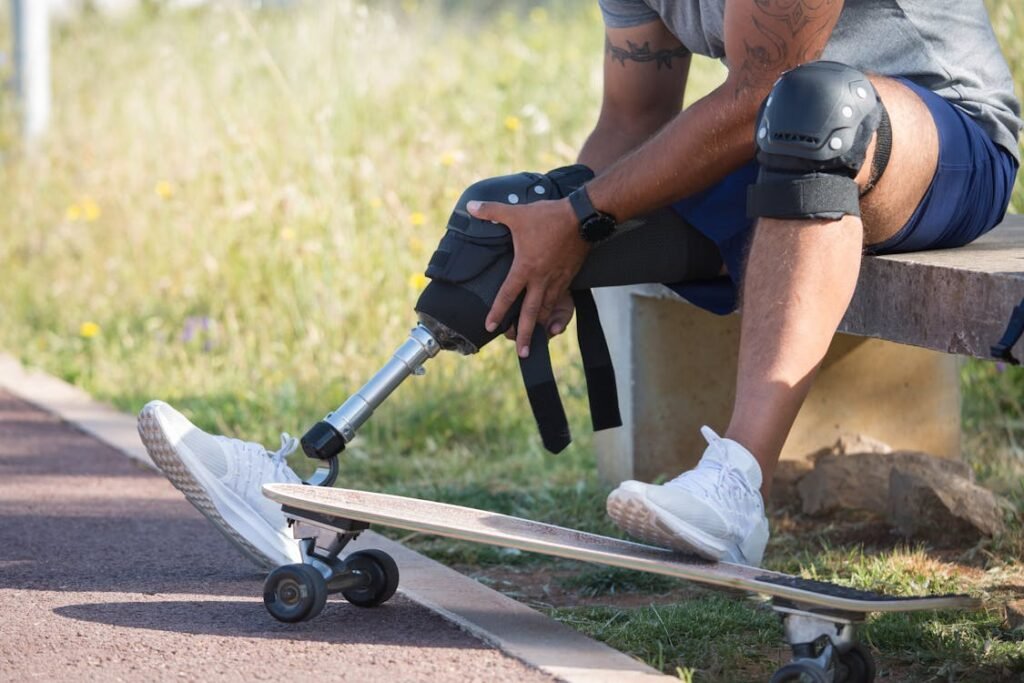
Bringing It All Together: The Future of Personalized Weight-Bearing
Creating Prosthetics That Feel Personal
As AI, smart sensors, and adaptive materials continue to grow in the world of prosthetics, one thing is becoming clear—the future is personal.
Every person is different. Their body, their lifestyle, their goals, and even how they walk or stand—all of it is unique. And now, prosthetic design is finally starting to reflect that.
Gone are the days when one design was expected to work for everyone. In the future, prosthetics will be built around you. Your stride. Your weight. Your habits. Even how your body changes throughout the day.
AI will study your daily movements, learn your patterns, and adjust support to match your rhythm. If your limb tends to swell after long walks, the socket will adapt automatically.
If you work on your feet all day, the limb will deliver stronger support through the heel and reduce strain on the joints. If you take the stairs two at a time, the knee will give you the boost you need—without you ever asking for it.
That kind of personal design is more than a convenience. It’s a breakthrough in how users live their lives. It makes the prosthesis feel like part of the body, not just something worn on the outside. And it builds trust—trust that your limb will respond when it matters most.
Keeping It Light Without Losing Strength
Another major focus in the evolution of prosthetic weight-bearing is lightness. The heavier the limb, the more energy it takes to move.
That added effort leads to fatigue, discomfort, and sometimes pain in the hips, back, or natural limb. But simply removing material isn’t the answer. The prosthetic still has to support the body safely and reliably.
That’s where composite materials are making a difference. Carbon fiber, for example, has long been valued for its strength-to-weight ratio. But now, we’re combining it with other smart materials that reduce overall weight while improving performance.
These hybrid materials are layered to respond to different kinds of stress—some layers compress under force, others rebound, and still others flex to follow movement.
This layered approach allows the limb to remain strong at the base, flexible at the joint, and cushioned at contact points. The result is a system that supports weight intelligently without dragging the user down.
Lighter limbs also make it easier to integrate sensors and small processors. The added technology no longer feels like a burden. This means even users with lower strength or smaller body frames can benefit from high-tech features without sacrificing comfort or control.
Using Data to Predict and Prevent Problems
One of the most promising uses of AI in prosthetic weight-bearing is predictive maintenance and health tracking. Imagine your prosthetic socket telling you that it’s starting to lose alignment before you even feel it.
Or a sensor in your foot detecting a change in your walking pattern that might signal muscle fatigue or a developing injury.
This type of proactive care is becoming possible through continuous data collection and analysis. Sensors track how pressure moves through the limb during different activities.
AI compares that data to what’s normal for the user. If something shifts—more force on the heel, less pressure on the toe, unusual side lean—the system flags it. This early warning can prevent problems before they become painful or costly.
For clinics, this kind of information is gold. It helps them plan follow-ups better, make smarter adjustments, and personalize rehab plans. For users, it builds a sense of control and partnership. The limb is no longer just reacting to discomfort—it’s helping avoid it altogether.
Some smart systems even connect to mobile apps, allowing users to track comfort levels, activity time, and maintenance schedules.
They can log when the limb feels “off” and send that data to the clinic instantly. This keeps care continuous and collaborative, even when in-person visits aren’t possible.
Reimagining Rehabilitation Through Technology
As prosthetics become smarter and more dynamic, the way we approach rehabilitation must also evolve. In the past, rehab focused on building strength and teaching users how to work around the limitations of their prosthesis.
Now, we’re shifting to a model that helps users work with their prosthesis—and get better results faster.
With real-time feedback and AI-powered gait analysis, rehab can now target specific issues immediately. If a user is leaning too far forward while walking, they can get instant visual or audio cues to help them correct it.
If they’re not putting enough weight on the prosthetic side, the system can help guide them into better balance.
Gamified rehab apps take this further by turning therapy into an engaging experience. These apps connect to the limb’s sensors and offer fun, task-based games that improve strength, coordination, and weight-bearing control. Users stay more motivated, and learning happens naturally through movement.
This combination of tech and therapy also opens up new doors for remote rehab. Users can work with clinicians from home, sharing data and progress through connected systems. This means more consistent support, especially for those in rural or hard-to-reach areas.

Biofeedback and Neuro-Integration: The New Frontier in Weight-Bearing
Merging the Body and the Machine
One of the most ambitious and promising directions in prosthetic weight-bearing design lies at the intersection of biofeedback and neuro-integration.
While adaptive materials and AI make the limb responsive to pressure and movement, these technologies aim to close the loop between what the brain wants and how the prosthesis responds—in real time.
In simpler terms, it’s about teaching the limb to “listen” to the body more directly, and eventually, to the brain itself. This isn’t science fiction anymore.
Research teams around the world—including some projects right here in India—are making rapid progress in decoding muscle signals and integrating them with artificial limbs. This is revolutionizing how load-bearing can be controlled—not just based on external movement but internal intent.
From Muscle Signals to Load Response
Most prosthetic limbs today use mechanical triggers or pressure-based inputs to guess what the user wants to do. But with myoelectric control, sensors placed on the skin detect the small electric signals muscles make when a person thinks about moving. These signals are then used to move the prosthetic limb.
The evolution now is in tying these signals not just to motion, but to how much force or weight the limb should handle. For example, lifting a heavy box requires more than just movement—it requires controlled resistance and power.
With integrated biofeedback, the prosthetic can adjust load-bearing stiffness in real time depending on what the muscles are telling it.
This approach gives users a much more natural sense of effort. Instead of manually switching settings or relying on pre-set responses, the limb reacts organically to the user’s intent.
The connection feels more immediate and intuitive—almost like the missing bridge between the mind and the machine is finally being rebuilt.
Neuro-Adaptive Weight Distribution
Going one step further, researchers are exploring direct neural interfaces—systems where electrodes connect closer to the nerves or even the spinal cord.
These setups offer richer data about the user’s intent and condition, creating an opportunity for highly personalized load distribution.
Imagine walking with a limb that knows how tired your body is. If your nerves signal fatigue, the prosthesis could begin to carry more load automatically. If your brain sends a fast-twitch command, the foot could stiffen for a quick sprint.
These dynamic shifts could change not just the function of weight-bearing, but its entire purpose—from support to collaborative movement.
While these technologies are still in development and come with high costs and ethical considerations, they represent a vision of prosthetic limbs that are truly cooperative systems—responsive, anticipatory, and in sync with the human nervous system.
The Role of Cognitive Comfort
There’s also a growing field of study around cognitive comfort in prosthetic use. Even when a prosthetic performs well physically, users may still feel disconnected if they have to concentrate too hard to operate it.
That mental load—often unspoken—affects endurance and satisfaction.
Neuro-integrated systems aim to reduce this mental strain. The less a user has to “think” about using their limb, the more naturally they move. And the better the weight is shared between the prosthesis and the body, the less likely it is that muscles will overcompensate, leading to stress or injury.
By merging biofeedback and weight-distribution data, future systems could offer the user both better physical support and greater emotional ease. It’s a holistic approach that recognizes the full experience of using a prosthetic—not just the mechanics, but the mental engagement it demands.
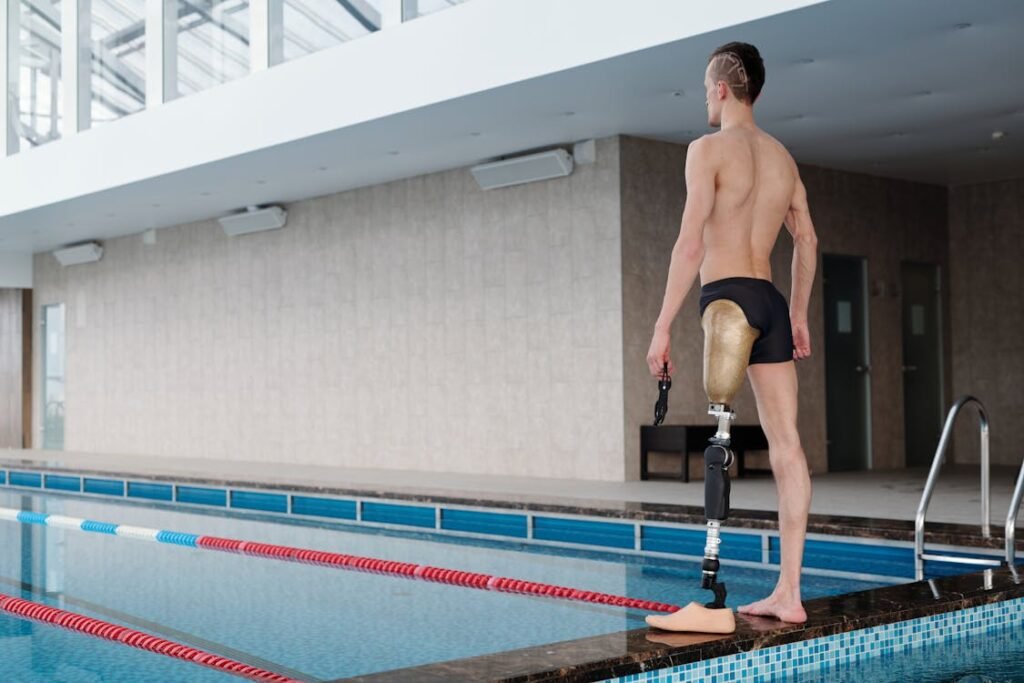
Climate-Aware Prosthetic Design: Adapting to Heat, Humidity, and Terrain
The Overlooked Role of Environment in Weight-Bearing
Most prosthetic design conversations center around mechanics, fit, or control. But few truly consider how climate—particularly temperature, humidity, and ground conditions—affects the performance and comfort of weight-bearing components.
Yet for people living in hot, humid, or rugged environments, these factors are not side issues—they are daily challenges that determine how wearable a prosthesis truly is.
A socket that fits perfectly in a cool, air-conditioned clinic may behave very differently when worn in 42°C heat on uneven terrain. Skin sweats, liners shift, and pressure builds up in ways that no lab test can simulate.
Materials expand, foam compresses differently, and joints may lose the crisp mechanical response they were designed to offer. These subtle but powerful effects change the way weight is distributed, and therefore, how the user walks, stands, or recovers.
In regions with heavy monsoon seasons or dusty roads, the issues multiply. Moisture may cause grip loss in feet or joints. Dust particles may affect moving parts. These aren’t just nuisances—they create safety risks and directly affect how well the prosthesis bears and balances body weight.
Designing for the Indian Climate
At Robobionics, we’ve encountered these issues in both rural and urban settings across India. The solution isn’t just better technology—it’s context-sensitive technology. That means building prosthetics with materials and structures that respond well to real-world conditions.
For instance, breathable socket liners made from hydrophobic fabrics help wick away sweat, reducing skin irritation. Heat-resistant composite materials avoid softening or warping in high temperatures. Special water-repellent foot covers ensure stability even on wet or muddy roads.
We’ve also explored ventilation grooves in socket design that promote air flow around the limb—especially crucial when the residual limb is inside the socket for several hours a day.
These small changes significantly improve comfort and pressure distribution during long wear periods in hot weather.
Even modular tread designs on foot prostheses allow for switching between smooth indoor and rough outdoor soles. This improves load distribution by ensuring each step gets the grip and ground feedback it needs—whether on polished tile or gravel paths.
Environment-Responsive Smart Materials
Looking into the future, we anticipate a rise in climate-reactive prosthetic materials—components that adapt automatically to changes in weather or temperature.
Imagine a socket liner that tightens slightly in cooler temperatures to ensure a snug fit, but loosens gently when the limb swells in heat. Or foot materials that stiffen when wet for added stability, then return to soft flex indoors.
These changes would require no user input and could be triggered by embedded temperature and humidity sensors.
For weight-bearing performance, this means a more stable, consistent experience, no matter where the user goes. It removes the need to constantly monitor fit or worry about the limb feeling different from morning to evening.
That consistency is critical not only for comfort but for preventing fatigue and pressure injuries, which tend to occur when users unconsciously adjust their gait due to environmental discomfort.
Local Materials for Local Conditions
Another approach is leveraging locally sourced materials that naturally suit the regional climate. Materials traditionally used in Indian crafts or textiles are now being examined for their potential in prosthetic design.
These include plant-based foams, organic rubbers, and lightweight woven supports—all of which may offer better thermal performance and breathability than some high-tech synthetics.
By combining local material wisdom with modern engineering, we can create weight-bearing components that not only perform well but also align with the lifestyle, climate, and resources of the user. This is not just innovation—it’s sustainability in practice.
Conclusion
The future of prosthetic weight-bearing design is moving far beyond simple support. With the rise of AI, adaptive materials, and responsive systems, prosthetics are becoming more intelligent, personal, and aware of their environment. From real-time adjustments to climate-resilient materials and even neuro-integrated responses, the goal is clear—a prosthetic that not only fits but truly lives with the user.
These innovations are not just about technology. They’re about restoring energy, reducing fatigue, and helping people move confidently—whether it’s across a crowded city street, up a flight of stairs, or through a long day at work. By designing for real lives, in real conditions, we’re not just changing how prosthetics are made—we’re changing what they make possible.
At Robobionics, we believe the future lies in listening deeply—to the body, the brain, the climate, and the community. And in doing so, we’re building more than prosthetics. We’re building freedom.



